| Srl | Item |
| 1 |
ID:
120285
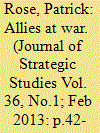

|
|
|
|
|
| Publication |
2013.
|
| Summary/Abstract |
This article compares the philosophy and practice of command in the British and US Armies during the Italian Campaign of 1943-44. It assesses pre-war influences on the command approach adopted by each army, and shows how refinements derived from wartime experience enabled British and American commanders to successfully utilise mission command principles to outfight the German Army in the latter years of World War II. This examination directly challenges the historical consensus that Allied commanders were disadvantaged by an inability to exploit the advantages of mission command, and that the German Army retained superior command practices, despite its other failings, throughout the fighting between 1939 and 1945. These conclusions hold additional relevance to modern military organisations which have emphasised mission command as the optimal solution to effective command in battle since the 1980s, but from an inaccurate understanding of German, British and American command traditions and experience that persists to this day.
|
|
|
|
|
|
|
|
|
|
|
|
|
|
|
|
| 2 |
ID:
031705
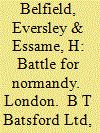

|
|
|
|
|
| Publication |
London, B T Batsford Ltd, 1965.
|
| Description |
239p.Hbk
|
|
|
|
|
|
|
|
|
|
|
|
Copies: C:1/I:0,R:0,Q:0
Circulation
| Accession# | Call# | Current Location | Status | Policy | Location |
| 000187 | 940.5421442/BEL 000187 | Main | On Shelf | General | |
|
|
|
|
| 3 |
ID:
117950


|
|
|
|
|
| Publication |
2012.
|
| Summary/Abstract |
Using the German Army from 1916 to 1918 as a case study, this article demonstrates a different form of military innovation than has hitherto been analysed by literature on the subject. During World War I, the German Army innovated by spreading knowledge between units rather than up and downthe chain of command. Thus, this army used 'horizontal innovation', rather than vertical innovation to change how it fought in the midst of battle. Although combat in World War I is significantly different from operations today, horizontal innovation offers armed forces a means by which to transform themselves much more rapidly than the traditionally recognised forms of military innovation.
|
|
|
|
|
|
|
|
|
|
|
|
|
|
|
|
| 4 |
ID:
131425
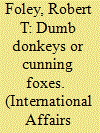

|
|
|
|
|
| Publication |
2014.
|
| Summary/Abstract |
The idea that the armies of the First World War were incapable of learning is one of the most enduring myths of the conflict. This image of 'lions led by donkeys' has proved difficult to modify, despite the sizeable scholarly literature on the tactical, technological and organizational adaptation and innovation undergone by all armies during the war. By examining the British and German armies as learning organizations during the war, this article contributes to the growing literature on wartime adaptation and innovation, as well as the wider literature on organizational learning in wartime. It demonstrates how the organizational cultures of these two armies shaped the way in which they learned, predisposing the British army towards radical, often technological, solutions to the tactical and operational challenges of the First World War battlefield, while inclining the German army towards incremental and tactical solutions to the same problems.
|
|
|
|
|
|
|
|
|
|
|
|
|
|
|
|
| 5 |
ID:
097942


|
|
|
| 6 |
ID:
114371
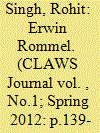

|
|
|
| 7 |
ID:
133762


|
|
|
|
|
| Publication |
2014.
|
| Summary/Abstract |
According to the official Soviet historiography, the defenders of the Brest fortress (today in Belarus) resisted the German troops who attacked on 22 June 1941, for 32 days. The Soviet soldiers would rather perish than surrender; hardly anybody would be captured. On this basis the Fortress was granted the title 'Hero-Fortress', and a huge memorial was built on the site of the battles of June 1941. The author of this article analyzed German documents concerning the daily losses in dead and wounded of the Wehrmacht and captured Red Army soldiers. He concludes that these numbers can be used as an indicator of endurance and intensity of the fighting for the Brest fortress. The conclusions differ strongly from the assertions of the official narrative.
|
|
|
|
|
|
|
|
|
|
|
|
|
|
|
|
| 8 |
ID:
125676
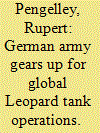

|
|
|
|
|
| Publication |
2013.
|
| Summary/Abstract |
The German army is due to begin troops trails with its newly upgraded Leopard 2A7 tanks in 2014, when the first of the upgrades is expected to be delivered by Krauss-Maffei Wegmann (KMW).
|
|
|
|
|
|
|
|
|
|
|
|
|
|
|
|
| 9 |
ID:
102265
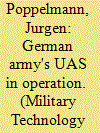

|
|
|
| 10 |
ID:
038646
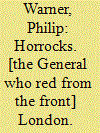

|
|
|
|
|
| Publication |
London, Hamish Hamilton, 1984.
|
| Description |
xi, 195p.Hbk
|
| Standard Number |
0241113121
|
|
|
|
|
|
|
|
|
|
|
|
Copies: C:1/I:0,R:0,Q:0
Circulation
| Accession# | Call# | Current Location | Status | Policy | Location |
| 026912 | 923.543/WAR 026912 | Main | On Shelf | General | |
|
|
|
|
| 11 |
ID:
133761
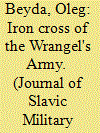

|
|
|
|
|
| Publication |
2014.
|
| Summary/Abstract |
This article is based on little-known sources and unpublished documents and traces the fates of some White Army veterans, who during WWII served in the German Army, holding a rank of sonderführer. Some of them were evacuated to Gallipoli from Crimea in November 1920 (gallipoliytsy). The topic of Nazi administration attitude toward the use of Russian emigrants on the front is also touched upon. Special attention is given to the biographies of Russian emigrant interpreters in the 9th Army of the Wehrmacht. It is concluded that the final aims and motivation of Nazis and White émigrés were different. Realization of that contradiction helps the researcher to understand why a part of Russian military emigration had chosen collaboration and joined Hitler's 'crusade against Bolshevism'.
|
|
|
|
|
|
|
|
|
|
|
|
|
|
|
|
| 12 |
ID:
157462


|
|
|
| 13 |
ID:
115569


|
|
|
| 14 |
ID:
137559


|
|
|
|
|
| Summary/Abstract |
Of the numerous events that comprised the Russo-German conflict of 1941–1945 but have since been almost forgotten, one of the most significant may have been the Soviet offensive that swept across the western Ukraine during the spring of 1944. Generally referred to as the second stage of the Soviet Dnieper-Carpathian Offensive Operation, in reality this offensive had a major, if usually unappreciated, influence upon the course of the Second World War. By closely examining the impact it had upon the German Wehrmacht, specifically in terms of German force dispositions and resource allocations, this article argues that the Soviet spring offensive in the western Ukraine played a major role in shaping the subsequent course of events in both Normandy and across the Eastern Front during the summer of 1944.
|
|
|
|
|
|
|
|
|
|
|
|
|
|
|
|
| 15 |
ID:
132459
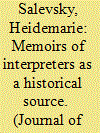

|
|
|
|
|
| Publication |
2014.
|
| Summary/Abstract |
There exist incompatible depictions of the Second World War, and specifically of the year 1941. Numerous documents from the archives now available in Moscow and Washington invite comparison with the memoirs of contemporary witnesses. The present article first describes the situation in German-Soviet relations before 22 June 1941. Then it contrasts the memoirs of the interpreters involved (in the German Embassy in Moscow, in the Soviet Embassy in Berlin, and at the delivery of the memorandum by Ribbentrop to Dekanozov) with newly available archive material and with the official records of the Nuremberg trial. The goal of this comparison is to form an assessment of these memoirs as subjective historical sources and to arrive at a new evaluation of their reliability.
|
|
|
|
|
|
|
|
|
|
|
|
|
|
|
|
| 16 |
ID:
086840
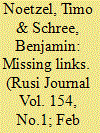

|
|
|
|
|
| Publication |
2009.
|
| Summary/Abstract |
The need for COIN operations to tackle the Taliban insurgency in Afghanistan is accepted by most coalition members. The German army has yet to adapt to this development. This article examines why the German political establishment still contests the need for counter-insurgency tactics in northern Afghanistan.
|
|
|
|
|
|
|
|
|
|
|
|
|
|
|
|
| 17 |
ID:
125755
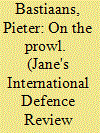

|
|
|
|
|
| Publication |
2013.
|
| Summary/Abstract |
German troops deployed in regional command north for International Security Assistance Forces (ISAF) operations currently rely on the VFW-Sikorsky CG-53GS Stallion medium transport helicopter and coalition assets for troop transport and Medevac purpose.
|
|
|
|
|
|
|
|
|
|
|
|
|
|
|
|
| 18 |
ID:
132455
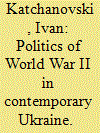

|
|
|
|
|
| Publication |
2014.
|
| Summary/Abstract |
This study examines the role of political factors in attitudes toward World War II in contemporary Ukraine. The research question is which factors determine public views of the principal warring sides and their leaders in Ukraine. The analysis of the 2012 Kyiv International Institute of Sociology survey shows that regional values, political party preferences, ethnicity, language, and age have significant effects on views of the Red Army and the Ukrainian Insurgent Army (UPA) during the war and attitudes toward the wartime activities of Joseph Stalin and Roman Shukhevych. Public perceptions of the German Army and Adolf Hitler in Ukraine do not vary much across regions, political parties, and ethnic, language, age, and sex groups.
|
|
|
|
|
|
|
|
|
|
|
|
|
|
|
|
| 19 |
ID:
133343


|
|
|
|
|
| Publication |
2014.
|
| Summary/Abstract |
Officer training varies between armies, but nearly all have a central institution that provides a common and shared foundation to all officer candidates and that is responsible for instilling the army's ethos and traditions
|
|
|
|
|
|
|
|
|
|
|
|
|
|
|
|
| 20 |
ID:
102842
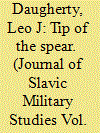

|
|
|
|
|
| Publication |
2011.
|
| Summary/Abstract |
Starting with the election of Germany's first postwar government in 1949, the Western Allies, most notably the United States and Great Britain, came to the conclusion that in order to strengthen the defenses of Western Europe against a possible Soviet invasion, a viable German Army, free of the militarism and influence from its World War II predecessor, would be necessary for the defense of not only Germany but of Western Europe itself. After surmounting serious French objections to the creation of standing German Army on its border, the government of Chancellor Konrad Adenauer set about to create a West German Army or "Bundeswehr" based on democratic principles and practices. This article, the first of four on the post-World War II German Armed Forces, is a history of the problems, organization, and fielding of what became the "tip" of NATO's sharp spear guarding against the Soviet Army from overrunning Western Europe - the West German Bundeswehr.
|
|
|
|
|
|
|
|
|
|
|
|
|
|
|
|